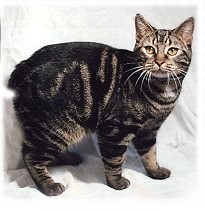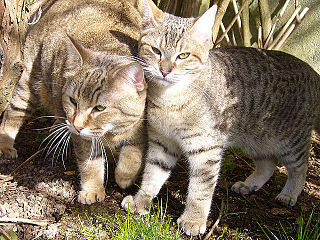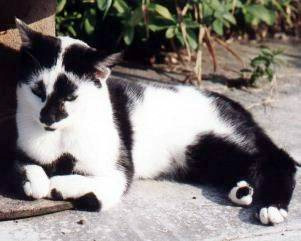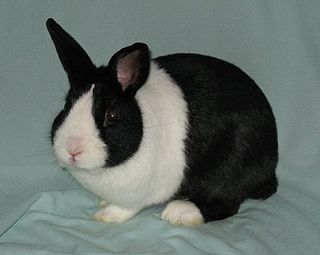
The Turkish Van is a semi-long-haired, standardised breed of domestic cat, which was developed in the United Kingdom from a selection of cats obtained from various cities of modern Turkey, especially southeast Turkey. The breed is rare, is one of the larger breeds, and is distinguished by the Van pattern, where the colour is restricted to the head and the tail, and the rest of the cat is white; this is due to the expression of the piebald white spotting gene, a type of partial leucism. A Turkish Van may have blue or amber eyes, or be odd-eyed.

The Manx cat is a breed of domestic cat originating on the Isle of Man, with a mutation that shortens the tail. Many Manx have a small stub of a tail, but Manx cats are best known as being entirely tailless; this is the most distinguishing characteristic of the breed, along with elongated hind legs and a rounded head. Manx cats come in all coat colours and patterns, though all-white specimens are rare, and the coat range of the original stock was more limited. Long-haired variants are sometimes considered a separate breed, the Cymric.

The Cymric is a Canadian cat breed. Some cat registries consider the Cymric a semi-long-haired variety of the Manx breed, rather than a separate breed. Except for the length of fur, in all other respects, the two varieties are the same, and kittens of either sort may appear in the same litter. The name comes from Cymru, the indigenous Welsh name of Wales, even though the breed is not associated with Wales. The name may have been chosen to provide a "Celtic" sounding moniker for the breed. While the breed's Manx bloodline originated from the Isle of Man, the long-haired variant is claimed to have been developed by Canada. The breed is called the Longhair Manx or a similar name by some registries.

The Scottish Fold is a distinctive breed of domestic cat characterised by a natural dominant gene mutation associated with osteochondrodysplasia. This genetic anomaly affects cartilage throughout the body, causing the ears to "fold", bending forward and down towards the front of the head. While this trait contributes to the breed's unique appearance, often described as "owl-like", it also causes health problems.

The American Bobtail is an uncommon breed of domestic cat which was developed in the late 1960s. It is most notable for its stubby "bobbed" tail about one-third to one-half the length of a normal cat's tail. This is the result of a cat body type genetic mutation affecting the tail development, similar to that of a Manx cat. The breed is not related to other short-tailed breeds, such as the Cymric cat, or the Japanese Bobtail or Kurilian Bobtail, despite the similar name and physical type—the breeding programs are entirely unrelated, and the genetic mutation causing the bobbed tail are known to be different, as the mutation causing the American Bobtail's short tail is dominant; comparatively, the Japanese Bobtail, for example, has a tail mutation that is recessive.

The Japanese Bobtail is a breed of domestic cat with an unusual bobtail more closely resembling the tail of a rabbit than that of other cats. The breed was first developed in Japan, and registered officially in the 1960s. The breed has been known in Japan for centuries, and it frequently appears in traditional folklore and art. Japanese Bobtails are believed to be derived from domestic and feral populations of kinked-tailed cats widespread throughout Southeast Asia and southern China.
Manx is an adjective describing things or people related to the Isle of Man:

The Snowshoe is a rare breed of domestic cat originating in the United States of America in the 1960s. The Snowshoe is a short-haired bicolour colourpoint breed. Snowshoes were first produced when a Siamese breeder's cat gave birth to three kittens with white feet. The breeder, Dorothy Hinds-Daugherty, then began a breeding program to produce what were originally called "Silver Laces", crossing the strangely marked Siamese cats with bicolour American Shorthair cats and other breeds. Despite having existed for 45 years, Snowshoes are rare due to the difficulty of reproducing the correct coat markings.

The Pixie-bob is a breed of domestic cat claimed to be the progeny of naturally occurring bobcat hybrids. However, DNA testing has failed to detect bobcat marker genes, and Pixie-bobs are considered wholly domestic for the purposes of ownership, cat fancy registration, and import and export. They were, however, selected and bred to look like American bobcats.

The Sokoke is natural breed of domestic cat, developed and standardised, beginning in the late 1970s, from the feral khadzonzo landrace of eastern, coastal Kenya. The Sokoke is recognized by four major cat pedigree registry organizations as a standardised cat breed. It is named after the Arabuko Sokoke National Forest, the environment from which the foundation stock was obtained, for breed development primarily in Denmark and the United States. The cat is long-legged, with short, coarse hair, and typically a tabby coat, though specific lineages have produced different appearances. Although once rumored to be a domestic × wildcat hybrid, genetic study has not borne out this belief. Another idea, that the variety is unusually ancient, remains unproven either way. The native population is closely related to an island-dwelling group, the Lamu cat, further north.

The Manx Loaghtan is a rare breed of sheep native to the Isle of Man. It is sometimes spelled as Loaghtyn or Loghtan. The sheep have dark brown wool and usually four or occasionally six horns.

A squitten is a cat with a genetic deformity which causes a partial formation or complete absence of the radius bone making it resemble a squirrel. These cats should be kept indoors and seen to by specialist veterinarians, as long term management of the condition is essential for quality of life in these cats. It is an example of a cat body type genetic mutation. The word is a portmanteau of squirrel and kitten.

The rex mutation is a genetic variation in mammals that results in soft curly fur. These effects are due to changes in the structure of groups of hairs and cross-section of individual hairs. The rexed coats are unusual but occur in cats, rats, rabbits, horses, and dogs. The mutations, infrequent and spontaneous, occur in a variety of genes and genetic regulatory structures. The diversity of genetic factors results in variable coat thickness/density and fur length. A similar mutation can affect the feathers of birds.

The Dutch rabbit, historically known as Hollander or Brabander, is a breed of domestic rabbit. It is easily identifiable by its characteristic color pattern and was once the most popular of all rabbit breeds. However, after dwarf rabbits were developed, the popularity of the Dutch rabbit declined. Nevertheless, the Dutch rabbit remains one of the top ten most popular breeds worldwide.
A natural bobtail is an animal's tail which due to a mutated gene grows unusually short or is missing completely. The genes for the shortened tail may be dominant or recessive.

The Kurilian Bobtail is a cat breed originating from the Russian Kuril Islands, as well as Sakhalin Island and the Kamchatka peninsula of Russia. Short- or long-haired, it has a semi-cobby body type and a distinct short, fluffy tail. The back is slightly arched with hind legs longer than the front, similar to those of the Manx. The breed is also called the Kuril Islands Bobtail, Kuril Bobtail and Curilsk Bobtail, and may be referred to without "Bobtail". It is sometimes also spelled Kurilean. The original short-haired variant is a natural breed, known on the islands for over 200 years. As selectively bred pets, they have been popular in USSR and to some extent other parts of Europe, especially for their rodent-hunting abilities, since the middle of the 20th century, but remained rare in North America as of 2011.

Cyprus cats, also known as Cypriot cats, Saint Helen cats, and Saint Nicholas cats, are a landrace of domestic cat found across the island of Cyprus. A standardized breed is being developed from them; among cat fancier and breeder organizations, it is presently fully recognized by the World Cat Federation (WCF), with breeding regulated by the World Cat Congress (WCC), under the name Aphrodite's Giant; and provisionally by The International Cat Association (TICA) as the Aphrodite. All three organizations permit shorthaired and semi-longhaired versions and no out-crossing to other breeds.















